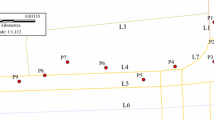Abstract
The availability of the Global Positioning System (GPS) trajectory data is increasing along with the availability of different GPS receivers and with the increasing use of various mobility services. GPS trajectory is an important data source which is used in traffic density detection, transport mode detection, map** data inferences with the use of different methods such as image processing and machine learning methods. While the data size increases, efficient representation of this type of data is becoming difficult to be used in these methods. A common approach is the representation of GPS trajectory information such as average speed, bearing, etc. in raster image form and applying analysis methods. In this study, we evaluate GPS trajectory data rasterization using the spatial join functions of QGIS, PostGIS+QGIS, and our iterative spatial structured grid aggregation implementation coded in the Python programming language. Our implementation is also parallelizable, and this parallelization is also included as the fourth method. According to the results of experiment carried out with an example GPS trajectory dataset, QGIS method and PostGIS+QGIS method showed relatively low performance with respect to our method using the metric of total processing time. PostGIS+QGIS method achieved the best results for spatial join though its total performance decreased quickly while test area size increases. On the other hand, both of our methods’ performances decrease directly proportional to GPS point. And our methods’ performance can be increased proportional to the increase with the number of processor cores and/or with multiple computing clusters.
Access this chapter
Tax calculation will be finalised at checkout
Purchases are for personal use only
Similar content being viewed by others
References
Ahmed, M., Wenk, C.: Constructing street networks from GPS trajectories. In: Epstein, L., Ferragina, P. (eds.) ESA 2012. LNCS, vol. 7501, pp. 60–71. Springer, Heidelberg (2012). https://doi.org/10.1007/978-3-642-33090-2_7
Carpenter, J.: Swifter: A package which efficiently applies any function to a pandas dataframe or series in the fastest available manner (2020). https://github.com/jmcarpenter2/swifter. Accessed 15 Mar 2020
Dabiri, S., Heaslip, K.: Inferring transportation modes from GPS trajectories using a convolutional neural network. Transp. Res. Part C Emerg. Technol. 86, 360–371 (2018). https://doi.org/10.1016/j.trc.2017.11.021
Dask: Dask: Scalable analytics in Python (2020). https://dask.org/. Accessed 15 Mar 2020
Eldawy, A., Mokbel, M.F.: SpatialHadoop: a mapreduce framework for spatial data. In: 31st IEEE International Conference on Data Engineering, ICDE 2015, Seoul, South Korea, April 13–17, 2015, pp. 1352–1363 (2015). https://doi.org/10.1109/ICDE.2015.7113382
ESRI: GIS Tools for Hadoop: Big Data Spatial Analytics for the Hadoop Framework (2020). http://esri.github.io/gis-tools-for-hadoop/. Accessed 05 May 2020
ESRI: Spatial Framework for Hadoop (2020). https://github.com/Esri/spatial-framework-for-hadoop. Accessed 05 May 2020
Friedrich, C.: Comparison of ArcGIS and QGIS for applications in sustainable spatial planning. Ph.D. thesis, uniwien (2014)
Geopy: Geopy: Python client for several popular geocoding web services (2020). https://geopy.readthedocs.io/en/stable/. Accessed 05 May 2020
Gouvernement du Québec: Déplacements MTL Trajet (2018). https://www.donneesquebec.ca/recherche/fr/dataset/vmtl-mtl-trajet. Accessed 15 Mar 2020
He, S., et al.: RoadRunner: improving the precision of road network inference from GPS trajectories. In: Proceedings of the 26th ACM SIGSPATIAL International Conference on Advances in Geographic Information Systems, pp. 3–12. ACM (2018)
Institute of Advanced Research in Artificial Intelligence: Traffic4cast Competition Track at NeurIPS 2019 (2020). https://www.iarai.ac.at/traffic4cast/traffic4cast-conference-2019/. Accessed 15 Mar 2020
Jiang, X., de Souza, E.N., Pesaranghader, A., Hu, B., Silver, D.L., Matwin, S.: TrajectoryNet: An Embedded GPS Trajectory Representation for Point-based Classification Using Recurrent Neural Networks, pp. 192–200 (2017)
Karagiorgou, S., Pfoser, D.: On vehicle tracking data-based road network generation. In: Proceedings of the 20th International Conference on Advances in Geographic Information Systems, pp. 89–98. SIGSPATIAL ’12, ACM (2012). https://doi.org/10.1145/2424321.2424334
Mnih, V., Hinton, G.E.: Learning to detect roads in high-resolution aerial images. In: Daniilidis, K., Maragos, P., Paragios, N. (eds.) ECCV 2010. LNCS, vol. 6316, pp. 210–223. Springer, Heidelberg (2010). https://doi.org/10.1007/978-3-642-15567-3_16
Papadomanolaki, M., Vakalopoulou, M., Zagoruyko, S., Karantzalos, K.: Benchmarking deep learning frameworks for the classification of very high resolution satellite multispectral data. ISPRS Ann. Photogrammetry Remote Sens. Spatial Inform. Sci. 3(7), 83–88 (2016). https://doi.org/10.5194/isprs-annals-III-7-83-2016
PostGIS: Spatial and Geographic objects for PostgreSQL (2020). https://postgis.net/. Accessed 15 Mar 2020
PostgreSQL: PostgreSQL (2020). https://www.postgresql.org/. Accessed 15 Mar 2020
QGIS: A Free and Open Source Geographic Information System (2020). https://qgis.org/. Accessed 15 Mar 2020
Sun, T., Di, Z., Che, P., Liu, C., Wang, Y.: Leveraging crowdsourced GPS data for road extraction from aerial imagery. In: Proceedings of the IEEE Conference on Computer Vision and Pattern Recognition, pp. 7509–7518 (2019)
Wang, F., Aji, A., Vo, H.: High performance spatial queries for spatial big data. SIGSPATIAL Special 6(3), 11–18 (2015). https://doi.org/10.1145/2766196.2766199
Zacharatou, E.T., Doraiswamy, H., Ailamaki, A., Silva, C.T., Freire, J.: GPU rasterization for realtime spatial aggregation over arbitrary polygons. Proc. VLDB Endowment 11(3), 352–365 (2017). https://doi.org/10.14778/3157794.3157803
Zhang, J., You, S.: CudaGIS: report on the design and realization of a massive data parallel GIS on GPUs. In: Proceedings of the 3rd ACM SIGSPATIAL International Workshop on GeoStreaming, IWGS 2012, pp. 101–108 (2012). https://doi.org/10.1145/2442968.2442981
Zhang, J., You, S., Gruenwald, L.: U2Stra: high-performance data management of ubiquitous urban sensing trajectories on gpgpus. In: International Conference on Information and Knowledge Management, Proceedings, pp. 5–12 (2012). https://doi.org/10.1145/2390226.2390229
Zhao, L., Chen, L., Ranjan, R., Choo, K.K.R., He, J.: Geographical information system parallelization for spatial big data processing: a review. Cluster Comput. 19(1), 139–152 (2016). https://doi.org/10.1007/s10586-015-0512-2
Zheng, Y., Zhang, L., **e, X., Ma, W.Y.: Mining interesting locations and travel sequences from GPS trajectories. In: Proceedings of the 18th International Conference on World Wide Web - WWW ’09, pp. 791–800 (2009). https://doi.org/10.1145/1526709.1526816
Author information
Authors and Affiliations
Corresponding author
Editor information
Editors and Affiliations
Rights and permissions
Copyright information
© 2021 Springer Nature Switzerland AG
About this paper
Cite this paper
Gengeç, N.E., Tarı, E. (2021). Performance Evaluation of GPS Trajectory Rasterization Methods. In: Gervasi, O., et al. Computational Science and Its Applications – ICCSA 2021. ICCSA 2021. Lecture Notes in Computer Science(), vol 12949. Springer, Cham. https://doi.org/10.1007/978-3-030-86653-2_1
Download citation
DOI: https://doi.org/10.1007/978-3-030-86653-2_1
Published:
Publisher Name: Springer, Cham
Print ISBN: 978-3-030-86652-5
Online ISBN: 978-3-030-86653-2
eBook Packages: Computer ScienceComputer Science (R0)




